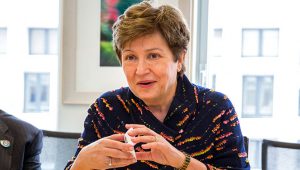Kristalina Georgieva, CEO of the World Bank: Empowering Communities

CEO: Kristalina Georgieva
Worldwide, around 500 million people live in “fragile situations,” mostly caused by armed conflict. Climate change threatens to add another hundred million or so people to that tally by 2030 – just thirteen years from now. And of the 800 million people living in extreme poverty, most live in middle income countries. World Bank CEO Kristalina Georgieva leads about 10,000 development professionals of the International Bank for Reconstruction and Development (IBRD) and the International Development Association (IDA) – the World Bank’s arms for middle-income and poor countries that mobilise funds and find solutions to the world’s most taxing and intractable challenges.
A passionate humanitarian who was responsible for the European Union’s emergency aid budget between 2010-2014, Mrs Georgieva applies a holistic approach to development that is focused on people, environment, and institutions both at the global and local level. Immediately before returning to the World Bank at the beginning of this year, where she previously held a number of senior positions, she was in charge of the EU’s €150 billion annual budget as a commission vice-president. Her top priority is helping the world’s most marginalised and vulnerable people. IDA maintains nearly a thousand projects in 11,000 locations in 76 countries including many fragile states and small states for some $90bn. Just a few months ago, this fund saw its biggest replenishment in its 50-years history, with $75 billion to invest over the next three years.
“Today’s World Bank is a veritable laboratory of financing as we seek to fill the investment gap. Pushing innovation in development is perhaps not new to the World Bank.”
“Those who have least access to the corridors of power are at risk of not having their voices heard. Yet, lasting success is only possible through the inclusion of all people, women and men, for ethical, moral, and economic reasons,” she says. For example, excluding women from economic life shears off growth by up to 37% of the countries’ GDPs. “Gender inequality stunts growth and causes billions to be forfeited – wealth that could have helped address housing, nutritional, and healthcare needs.”
Development remains a complex, long, and multi-faceted process. “Ushering young girls into schools means that better-educated women will eventually enter the workforce. This, in turn, assures that these young women have a disposable income which they’ll want to control through, for example, mobile banking. That promotes financial inclusion – a most important stepping stone. This all adds significantly to a woman’s dignity and sense of self-esteem. By controlling their own wages, quite a few women will seek to increase their income by investing in tools and starting micro businesses. Soon not just immediate family but entire communities benefit from their work and entrepreneurship.”
It is easier to implement projects that produce visible results in the short term. It is harder to maintain long-term investments in areas such as education. “Yet ignoring these vital areas virtually assures that a country will keep struggling to gain a measure of prosperity.” The bank builds a strong economic case for such interventions and backs them up by measuring the results. In Afghanistan, the number of children in school has increased eightfold from just a million over the last fifteen years. Most of them were boys but today 40% of all students are girls.
“Countries that fail to concentrate on their human capital are, simply put, setting themselves up as tomorrow’s losers.” The bank is working on the development of a Human Capital Index for countries and its 2018 World Development Report (WDR) Learning to Realize Education’s Promise highlights education’s crucial role in eradicating poverty.
The map of macro aspects of development issues that she is facing across emerging markets and developing economies is unnerving. “Think about just getting most children, boys and girls, into schools, and teaching them what is needed.” Some 600 million young people will shortly be entering the workforce – around two-thirds of them in developing nations. The jobs they seek do not yet exist and at the same time disruptive technologies are changing the nature of work as we know it. “Building the necessary physical and digital infrastructure required to embrace the future requires investments at scale. On the other hand, you have trillions of dollars earning low returns and seeking greater profitability. How do we identify and remove the barriers to make what should be, but isn’t, happening – shifting significant resources towards development? This includes working on the regulatory and investment environment, systematically going through obstacles to investments, and managing risks. And this is where IBRD, which has invested just under $700 billion in middle-income countries since its establishment, is shifting its focus.” Mobilising resources at scale towards development is difficult, but particularly daunting when it needs to take place in countries torn apart by conflicts or plagued by weak institutions. This is when the concessional resources of IDA can be effective in crowding in private finance.
An important part of making investing in developing countries less risky is helping manage vulnerabilities to disasters and shocks. This goes beyond the bank’s traditional role in helping countries maintain a strong macro-economic environment. It considers outbreaks of catastrophic infectious disease to be one of the greatest systemic risks facing the global community. Its first-ever pandemic bond was oversubscribed, raising $322m in two separate issues with a three-year maturity. The bank simultaneously issued $100m worth of swaps for added protection. The bond has regular coupons attached to compensate investors for a loss of value in case a pandemic breaks out. The issue forms part of a strategy to create an insurance market for pandemic risk and leverages the bank’s capital market expertise and unparalleled understanding of public healthcare issues. Previously it has successfully launched $1.6bn worth of catastrophe bonds to respond to natural disasters and sustainable development bonds that promote ethical and impact investing. These contingency instruments proved their value during the recent wave of natural disasters which struck the Caribbean and Mexico.
Mrs Georgieva is keen to leverage the World Bank’s leadership role in financial engineering as a catalyst for development and sustainability. “Today’s World Bank is a veritable laboratory of financing as we seek to fill the investment gap. Pushing innovation in development is perhaps not new to the World Bank. The scale and speed of the effort is, however, unprecedented and now matches global needs more closely.” The bank is working intensively in areas like clean energy, climate-smart agriculture, sustainable urbanisation, and disaster risk management. It is committed to reaching the target of 28% climate-related programmes by 2020. It pioneered the introduction of green bonds, a market which has surpassed $100 billion, and is working with countries on the development of green bond markets, which led to the issuance of the world’s first green sukuk (Islamic bond) by a Malaysian issuer earlier this year.
But the CEO is just as keen to give equal weight to the bank’s effectiveness at the micro-level as she is on sharpening its impact at the macro-level. “People know what they need and have a keen sense of priority. We need to find the voices of citizens so they can define their own pathways for development.” Mr Georgieva recalls a programme in Indonesia, implemented at the height of the financial crisis in Asia. Instead of allocating block grants the traditional way, it was decided to hand the available funds directly to local authorities – those in direct contact with the population. All it took to ensure that the funds reached the people for whom they were intended was a whiteboard. “We first asked the community what projects were most needed and how much money was required for their implementation. We then proceeded to write all relevant details – project description, cost, and the name of the official responsible – on a whiteboard placed in the centre of the community. That was all.”
Learning experiences such as these have helped steer the World Bank towards a slightly different direction. Its staff is actively working in the field with people who need their help and listening to what they have to say. This boots-on-the-ground policy helps the World Bank expand its presence in under-served places so that it can build the conditions that help it engage and gain trust. This is particularly important for succeeding in countries that have the highest needs but the weakest capacity to deal with them.
Empowering communities to take charge of and invest in their own progress increases the effectiveness of projects by reducing the costs associated with monitoring. Mrs Georgieva’s faith in people and her commitment to empowering them to fulfil their potential is her greatest motivation. “I strongly believe that communities know best how to meet the challenges they face. It is up to us to provide the resources, and up to them to achieve the best possible outcomes.
You may have an interest in also reading…
PwC, South Africa: Contributing to the Development of South Africa
All businesses need to know about Broad-Based Black Economic Empowerment (B-BBEE). Following the demise of the apartheid regime in South
Otaviano Canuto, IMF: Trade Opening Could Be a Source of Growth for Brazil
International trade has undergone a radical transformation in the past decades as production processes have fragmented along cross-border value chains.
Princess Ameerah Al-Taweel: Saudi Princess at Forefront of Women´s Lib – “We Want Change”
It is quite difficult to introduce Ameerah Al-Taweel without mentioning the fact that she is the wife of Saudi Prince


















































































